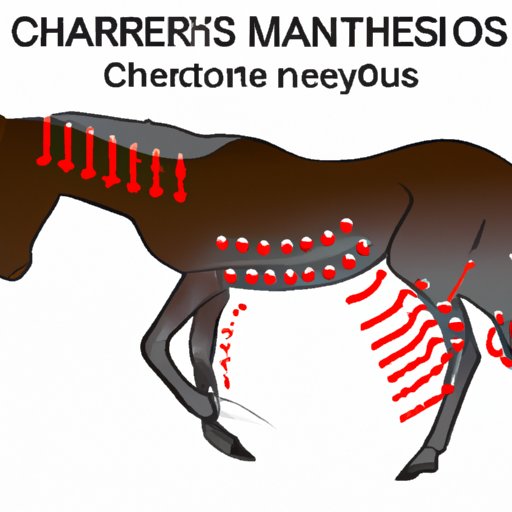
I. Introduction
Have you ever been suddenly woken up in the middle of the night by a sharp, painful cramp in your leg? If you have, you’ve experienced a Charley Horse. Charley Horses are a common occurrence and can happen to anyone, from athletes to pregnant women. This article will explain the science behind Charley Horses, the top causes of Charley Horses, and how to prevent and treat them.
II. Uncovering the Mystery: The Science Behind Charley Horses
First, we need to understand how muscles work. Muscles are made up of fibers that contract with the help of chemicals in the body such as ATP. When a muscle contracts and doesn’t release, it can cause a tightness, cramping, and spasms. These spasms are what we call Charley Horses.
III. The Top Causes of Charley Horses and How to Prevent Them
There are several common causes of Charley Horses, including dehydration, electrolyte imbalances, overuse or muscle strain, and poor circulation.
– Dehydration: It’s essential to stay hydrated, and a lack of water can cause a loss of minerals and electrolytes like potassium, magnesium, and calcium, which can directly result in Charley Horses. To prevent them drink plenty of water and eat fruits and vegetables rich in those minerals.
– Electrolyte imbalances: Imbalances in minerals and electrolytes can also be the cause of Charley Horses. You can get electrolytes from foods like bananas, nuts, and whole grains. Or you can drink sports beverages that contain electrolytes. But don’t overdo it as too much can have an adverse effect on your body.
– Overuse or Muscle Strain: Overworking or straining your muscles can lead to Charley Horses. Avoid overdoing it with exercise or activity. Build up intensity levels slowly to avoid injuring your muscles.
– Poor Circulation: Poor circulation can cause Charley Horses, particularly in the elderly. Taking regular breaks during long periods of sitting or standing and performing stretching regularly can help improve circulation.
IV. Charley Horses Explained: What They Are and Why They Happen
A Charley Horse occurs when there is an involuntary spasm or contraction of the muscle. All muscles in the body are susceptible, but Charley Horses are common in the calf muscles, as they work hard to pump blood back to the heart from the feet and legs. Charley Horses happen to people of all ages and can be caused by several factors, such as those mentioned in the previous section.
V. I Got a Charley Horse—Now What? Tips for Treatment and Recovery
Charley Horses can be excruciating and can cause weakness in the muscle, especially after the episode. If you experience one, immediately stop the activity you’re doing and rest the muscle. You can also apply heat or ice and massage the affected muscle to promote blood flow and healing. Light stretching can also relieve the discomfort and reduce muscle tension. However, make sure to avoid putting too much pressure and stretching too hard, as this can lead to further injuries. In worse cases, over-the-counter painkillers or prescriptions may be advised. Speak to your medical professional if your Charley Horses frequently occur.
VI. The Link Between Charley Horses and Dehydration: How Much Water Do You Really Need?
Dehydration is one of the major causes of Charley Horses. It’s essential to drink plenty of water throughout the day to keep your body hydrated. The recommended daily amount ranges from eight to ten glasses of water, based on weight and lifestyle. The duration and rigidity of physical activity you do will have some impact on how much water your body will require the most.
VII. Preventing Charley Horses during Exercise: Proper Stretching Techniques
Stretching is one of the best ways to improve flexibility, increase blood flow, and minimize the risk of Charley Horses. Focus on stretching the affected area before and after physical activity, or when you feel the cramp coming on. It’s essential to do it gently and to never bounce or force it too far. Concentrate on slow movements and holding still for 30 seconds to a minute.
VIII. Charley Horses and Mineral Deficiencies: How to Get the Nutrients You Need to Avoid Them
Mineral deficiencies are another established cause of Charley Horses. Minerals play a vital role in muscle function and maintaining the electrolyte balance in the body. Magnesium and potassium, in particular, play a crucial role in managing muscle function, and our body needs the right amount of it every day. To ensure enough minerals intake, incorporate foods like bananas, spinach, fish, nuts, whole grains, and milk into your diet.
IX. Conclusion
Charley Horses can happen to anyone and at any time, and can be painful and affect day to day life. The causes could be due to dehydration, electrolyte imbalances, overuse or strain, and poor circulation. To avoid Charley Horses, it is necessary to stay hydrated, take regular breaks during long periods of sitting or standing, stretch regularly, and avoid strenuous activities particularly when starting out. Charley Horses are uncomfortable, but following the tips mentioned above can help in managing them and reaching the relief needed for a speedy recovery.




